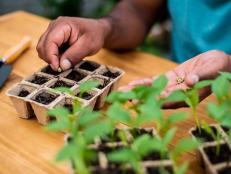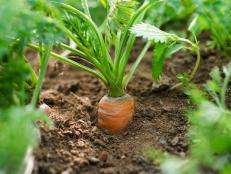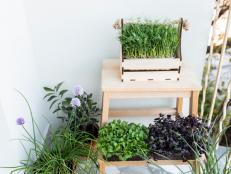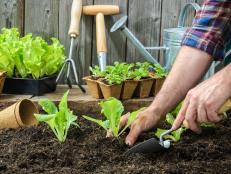How to Grow a Patch of Strawberries
Nothing’s sweeter than a berry fresh from the garden.

EdwardSamuelCornwall/Getty Images
A weekend ride to a nearby farm offering pick-your-own strawberries is a delicious summertime tradition, but anyone with a small plot of ground or room for a few pots on the patio can turn that occasional treat into a weekly event. Life is certainly sweet when you can gather a basket of fresh, ripe strawberries grown in your own strawberry patch. Luckily, growing strawberries is easy, and with time-tested varieties like Earliglow, Honeoye and Tristar, a steady supply of these flavorsome fruits is well within reach of even the most inexperienced gardener.
The Basics
There are three main types of strawberries available to the home gardener, June-bearing, ever-bearing, and day neutral. June-bearing strawberries produce a large yield in a short period of time, starting in late spring and ending in mid-summer. Ever-bearing types provide at least two harvests, one in early summer and again in early fall. Day neutral plants flower and fruit throughout the growing season, yielding at least three harvests.
Strawberries are extremely sensitive to local conditions. A variety that performs well in one area may do poorly in another, so try more than one kind. Plants will begin flowering once spring temperatures are consistently warm. June-bearing varieties should be ready to pick about four weeks after flowering. Ever-bearing and day neutral types also start flowering with warm temperatures and take just as long to make fruit, but they keep flowering all summer.
Tip: The woodland strawberry, or fraises des bois, also called alpine strawberry, is a day neutral species. They produce small, sweet fruit with just two to three berries per plant per week. Shade tolerant by nature, they’re an adaptable addition to flower beds and pots.

lucentius/Getty Images
Start with Bareroot or Potted Plants
The shortest route to fresh strawberries is to buy ready-to-grow plants in the spring. Mail-order strawberries will be dormant bare root plants shipped at the appropriate time for planting in your region. Store them in the refrigerator upon delivery and plant them as soon as possible, soaking their roots in water for 30 minutes prior to planting. Do not allow the roots to dry out before or after planting. Fresh green growth should appear in a week’s time. Strawberry plants sold at garden centers come in pots. Select vigorous plants with fresh green shoots and lots of leaves. Be sure to keep the soil in the pot moist until planting time.
Prepare Your Plot
Find a sunny spot for your strawberry patch. Strawberries need six to 10 hours of direct sunlight to produce fruit so stay away from large trees which will cast shade as well as compete for water and nutrients. Avoid low spots where water collects on rainy days. Instead, plant on high ground. This will minimize the threat of frost damage and increase air circulation to reduce fungal diseases.
Prepare the ground by removing any weeds or lawn and work some well-rotted compost into the soil to increase fertility and improve drainage. If you can’t find a sunny spot with good drainage, consider building a raised planter filled with prepared garden soil. Healthy strawberry plants can spread quickly so if you have limited space it may be best to grow them in containers or restricted beds.
Space your plants 18 to 24 inches apart in 12-inch wide rows spaced three to four feet apart. Ever-bearing and day-neutral varieties are less vigorous and should be planted closer, between eight and 10 inches apart. The result will be matted rows that suppress weeds. It’s safe to plant bareroot strawberries in early spring once the soil has thawed. Trim the roots to four to six inches in length and fan them out in the planting hole, then nestle the crown of the plant – where the roots meet the shoots – halfway below soil level. Strawberries sold in pots aren’t dormant and should only be planted after the risk of hard freezes are past. Plant them in the ground at the same depth they were in the pot. Firm the soil around each plant and water thoroughly.
Water, Feed and Weed as Needed
Keep plants watered just enough so they don’t dry out. One good soaking a week is usually enough. Water early in the day so the roots can absorb the water when the plant needs it and the foliage has time to dry off before nightfall. As your strawberries ripen, avoid overwatering because too much water will dilute the flavor of the berries. If your strawberries get off to a slow start feed them with a nitrogen rich organic fertilizer, like blood meal. Sprinkle a handful around each plant but do not scratch it into the soil. This can damage their shallow roots. Proactive weeding is essential to keep your strawberries happy. Hand-weed weekly at a minimum, avoiding the use of a hoe since it too can damage their roots.
Be Sure to Prune and Renovate
For the first few weeks after planting, pinch off any flower buds that appear. This will promote robust roots and shoots with ample energy to support the next wave of flowers that will develop into large, luscious fruits. “Runners,” or side shoots that emerge from the crown, will appear throughout the season. You can clip and plant them where you have growth gaps by gently pressing the end of the runner into the soil. If your plants make too many runners, simply cut them off and compost them.
Renovate June-bearing plants two weeks after their final harvest to help prevent fungal diseases and pest problems. First, trim plants one to two inches above the crown and remove the clippings, then thin the rows back to their original width. This will improve airflow through the patch, keeping the plants healthy and strong, and ensure a good crop next season. Do not renovate ever-bearing and day neutral strawberries; instead plan to replace them every third year.
Control Disease and Pest Problems
Help prevent fungal diseases on your strawberries by placing straw mulch under the plants and between the rows. It’s a good idea to remove and replace all straw mulch each season. Take care not to wound or bruise berries during harvest and always remove diseased or old mushy fruits. You can avoid root-rotting diseases by transplanting your strawberry patch to a different area of the garden every three to four years.
Foraging birds are more problematic than most insects. Savvy gardeners pick the fruit as soon as it is ripe or cover the plants with netting. There are also safe repellents, like sugar water and, believe it or not, Kool-Aid. Birds are unable to digest sucrose, and an ingredient in grape Kool-Aid is distasteful to them. Mix five pounds of table sugar into two quarts of water or mix four packets of Grape Kool-Aid in one gallon of water and apply either solution to the plants as the berries begin to color.

Westend61/Getty Images
Harvest and Enjoy
Strawberries generally ripen one month after full bloom and pollination. Once ripe, they should be harvested every other day. The best time to pick is early in the morning when berries are still cool and any dew on the plants has dried. The berries won’t ripen at the same time, so gather only those that are totally red. Strawberries ripen from the tip towards the leafy stem. Some varieties with large leafy caps stay white near the stem, which is normal, but most types will be completely red when ripe so only pick them when they are fully colored. Keep the picked berries out of direct sunlight and refrigerate them as soon as possible. Do not wash the berries until just prior to use to extend their storage life.
Overwinter Your Strawberry Plants
Let your strawberry plants rest for the winter with a nice cover of straw mulch as insulation. After two or three frosts have prepared the plants for the transition into winter, cover them with four inches of straw. You can remove this mulch next season after the danger of hard freezes has passed.
Related Content:

































